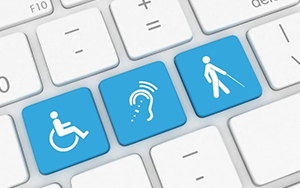
11 July 2024 | Hampton Digital Services Ltd
A Guide to Web Accessibility : Making the Web Work for Everyone
In today’s world, the internet is like a big city bustling with information, services and connections.
It’s where we shop, learn, play and work. But what if you can’t easily access this digital city? For millions of people worldwide with disabilities, navigating the web can feel like trying to find your way through a complicated maze without a map. That’s where web accessibility comes in and what prompted us to share this guide to web accessibility with you.What is Web Accessibility?
Web accessibility is all about making websites usable for everyone, including people with disabilities. The word disability encompasses a wide range of impairments, including visual, auditory, physical, cognitive, and neurological disabilities. Ensuring web accessibility involves removing barriers that may prevent individuals with disabilities from navigating, interacting with, and accessing online content effectively. In this blog, we’ll explore why web accessibility matters and how you can make your website welcoming and easy for everyone to use.
Why Web Accessibility Matters
Imagine trying to read a book with the letters all jumbled up or listening to a song with parts missing. That’s how it feels for some people when they try to use websites that aren’t accessible. Ensuring your website is accessible goes beyond mere compliance with regulations and laws; it’s a way to ensure that everyone, regardless of their abilities, can access the same information and services online. It’s like building a ramp for someone who uses a wheelchair or adding braille labels to an elevator button − it’s about making the world more inclusive and fair for everyone. Equal access to online resources enables people with disabilities to pursue education, employment, healthcare and entertainment on an equal footing with their peers.
Who Benefits from Web Accessibility?
Web accessibility isn’t just for people with disabilities − it benefits everyone. Have you ever tried to use a website on your phone and found it hard to read or navigate? Or maybe you’ve been in a noisy place and couldn’t hear the audio on a video? These are just a couple of examples of situations where accessible design can make a big difference for everyone, not just people with disabilities.
Tips for Making Your Website Accessible
Now that we understand why web accessibility is important, let’s talk about how you can make your website more welcoming and usable for everyone:
Use Clear and Simple Language: Write in plain language that’s easy to understand. Avoid using jargon or complicated words that might confuse people. Likewise, do not presume that everyone will understand abbreviations or acronyms that are specific to your business.
Semantic HTML: Properly structured headings, lists and landmarks (using semantic HTML elements) help users navigate websites more efficiently, particularly those using screen readers or other assistive technologies.
Provide Alternative Text for Images: When you add images to your website, make sure to include alternative text that describes what the image is showing. This helps people who use screen readers understand the content of the image.
Make Sure Your Website is Keyboard-Friendly: Many users with motor impairments can’t use a mouse and rely on a keyboard to navigate websites. Make sure all interactive elements on your site, like buttons and links, can be accessed and activated using only the keyboard.
Choose Colours Carefully: Use high-contrast colours for text and background to make your content easier to read, especially for people with low vision or colour blindness.
Provide Captions, Transcripts and Audio Descriptions for Multimedia Content: If you have videos or audio files on your website, make sure to provide captions or transcripts and audio descriptions so that people who are deaf, hard of hearing or visually impaired can still access the information.
Responsive Design: Create websites that are responsive and adaptable to various screen sizes and devices. Responsive design benefits users with disabilities who may use different devices or assistive technologies to access the web, ensuring a consistent and accessible user experience across different platforms.
Make Forms Easy to Fill Out: When designing forms, use clear labels and provide helpful instructions to guide users through the process. Also, make sure to clearly indicate any errors in the form submission.
Test Your Website with Real Users: You can test your website for accessibility using automated tools and manual audits but the most effective way to ensure your website is accessible is to test it with real users who have different disabilities and diverse accessibility needs. They can provide valuable feedback on what works well and what could be improved.
Conclusion
Web accessibility is about making the internet a more inclusive place where everyone can participate fully and equally. By following these simple tips and principles, you can make your website more welcoming and usable for people of all abilities. So let’s work together to create a digital landscape where everyone has the opportunity to thrive, regardless of their abilities or disabilities.
As always, we’re here if you have questions or would like to talk about whether HDS can help you.